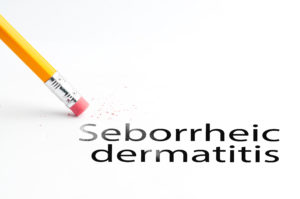About Seborrheic Dermatitis
About Seborrheic Dermatitis
Seborrheic dermatitis is a common relapsing form of eczema that causes red itchy rashes with sloughing white scales, particularly affecting areas of oily skin including the nose, forehead, and scalp.1 Seborrheic dermatitis has a bimodal distribution among newborns and middle to elderly aged adults.2 While mild forms affecting the scalp is referred to as simply “dandruff”, clinically significant forms that affects approximately 3% of the population may present with large disfiguring plaques of dense scales accompanied by “burning sensations.”3,4 In infants, seborrheic dermatitis commonly affects diaper areas and the scalp creating a thick and crusty, but nevertheless harmless and often self-resolving, “cradle caps.”5
The diagnosis of seborrheic dermatitis is made based on the patient’s clinical presentation.6 Although the exact cause of seborrheic dermatitis currently remains unknown, factors including scratching, hormones, genetics, emotional stressors, winter seasons, and yeasts (Pityrosporum and malassezia) have been implicated.7-9
While less severe cases of seborrheic dermatitis are self-resolving, common treatments for mild scalp involvement include selenium shampoo, while more severe lesions affecting non-hair bearing areas can be treated with topical steroids, antifungals, and immunomodulators.10-12
- Clark, G. W., Pope, S. M. & Jaboori, K. A. Diagnosis and treatment of seborrheic dermatitis. Am Fam Physician 91, 185-190 (2015).
- Siegfried, E. C. & Hebert, A. A. in J Clin Med Vol. 4 884-917 (2015).
- Johnson, B. A. & Nunley, J. R. Treatment of seborrheic dermatitis. Am Fam Physician 61, 2703-2710, 2713-2704 (2000).
- Johnson, M. T. & Roberts, J. Skin conditions and related need for medical care among persons 1-74 years. United States, 1971-1974. Vital Health Stat 11, i-v, 1-72 (1978).
- Borda, L. J. & Wikramanayake, T. C. Seborrheic Dermatitis and Dandruff: A Comprehensive Review. J Clin Investig Dermatol 3 (2015).
- Berk, T. & Scheinfeld, N. in P T Vol. 35 348-352 (2010).
- Paulino, L. C. New perspectives on dandruff and seborrheic dermatitis: lessons we learned from bacterial and fungal skin microbiota. Eur J Dermatol 27, 4-7, (2017).
- Zani, M. B., Soares, R. C., Arruda, A. C., de Arruda, L. H. & Paulino, L. C. Ketoconazole does not decrease fungal amount in patients with seborrhoeic dermatitis. Br J Dermatol 175, 417-421, (2016).
- Gupta, A. K. & Bluhm, R. Seborrheic dermatitis. J Eur Acad Dermatol Venereol 18, 13-26; quiz 19-20 (2004).
- Brenner, S. & Horwitz, C. Possible nutrient mediators in psoriasis and seborrheic dermatitis. II. Nutrient mediators: essential fatty acids; vitamins A, E and D; vitamins B1, B2, B6, niacin and biotin; vitamin C selenium; zinc; iron. World Rev Nutr Diet 55, 165-182 (1988).
- Egeberg, A., Andersen, Y. M. F., Gislason, G. H., Thyssen, J. P. & Skov, L. Differential disease burden and treatment patterns among adults with psoriasis and atopic dermatitis seen in hospital vs. private clinics. J Eur Acad Dermatol Venereol, (2017).

